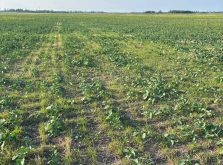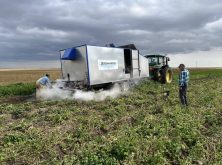To spray or not to spray? That is the question many farmers will be asking themselves in the coming weeks.
While it’s still too early to say what pest and disease forecasts will look like this season, it’s never too soon to start thinking about temperature and other factors that can help to determine the right — or wrong — time to apply pesticides.
Dan Johnson is a professor of environmental science and researcher with the University of Lethbridge who has studied grasshoppers extensively. He says one common fallacy in fighting the herbivorous pest is that the pyrethroid insecticides that are so effective against them begin to lose their efficacy when temperatures climb above 25 C.
Read Also

Claas brings 1000 Series SP forage harvesters to Canada
In mid-August, Claas unveiled its new line of Jaguar forage harvesters at an event in Visalia, California, deep in the heart of that state’s dairy region.
Pyrethroids are a special class of chemical that attack the nervous system of insects. They are fast-acting and especially effective against most chewing insects. They aren’t highly toxic to birds and mammals in most cases.
“The fact of the matter is that for decades it’s been on labels and it’s been on websites … that you shouldn’t spray pyrethroids on grasshoppers above 25 C. There’s never been any evidence that I’m convinced by for that [warning],” he says.
“Something happened long ago that made somebody say the reason it failed was temperature and ever since that’s just been gospel. As far as I can tell it’s false. I’ve seen all kinds of field trials with pyrethroids done under proper experimental conditions that showed no apparent impact from temperature.”

Johnson points out that a large lab study he and technician Craig Andrews conducted in the early ’90s bore that out.
The results of that study showed pyrethroids continue to work effectively at temperatures as high as 27 and 31 C. No temperature resulted in failure and warmer temperatures just resulted in higher grasshopper mortality.
Despite that, most such products continue to carry labels recommending they not be sprayed if the daytime temperature exceeds 25 C.
“As far as I can tell, it was just a mistake made sometime in the ’80s. It’s been there ever since. I have no idea why. It is possible that some rare combination of a certain species and a certain pyrethroid could have a temperature issue, but we have never seen it, and certainly not in the field,” he says.
All that said, Grainews does not recommend or endorse off-label use of any registered crop protection product.
“I’m a big advocate of reading the label and following the label. I think that has to be done,” Johnson says. “But I also think the labels have to be based on science.”
Johnson adds he doesn’t believe any additional research is required on the subject since it has already been studied extensively and there are other subjects that should be made a higher priority.
Scouting by species
Although grasshoppers can have a devastating impact on yield with crops such as wheat, soybeans and corn, most species aren’t considered pests. The two primary pest threats are the two-striped and clear-winged grasshoppers. They can usually be recognized by damage when there are large numbers.
Johnson says that’s why it’s important for farmers and the people they work with to get out into the field and conduct regular scouting to determine what kind of grasshoppers may be present. Even if pest grasshoppers are detected, it’s best to hold off on spraying if they are still hatching since pyrethroids won’t kill any insects that are still below ground. Any active grasshoppers seen during March and April are species that cause no crop or pasture damage.
Damage over numbers
Farmers should bear in mind when scouting for grasshoppers that visible damage, not insect counts, should determine whether to spray. “Visible damage is key, not count,” Johnson says.
“Sometimes I’ve seen 100 (grasshoppers) per square metre that aren’t damaging the crop, oddly enough. Other times, even eight per square metre can damage the crop. It all depends on how old they are, what kind they are, and how hot it is.”

Breakdown
Check out any of the multitude of farm forums available online and you are likely to find dozens of suggestions on when is the best time to spray your fields. One common suggestion is that spraying should be avoided when sunshine is intense and the UV index is high.
Johnson says while it’s true UV rays can influence the way some chemicals interact with plants, their impact on that interaction is quite low. Although some chemicals do break down fairly rapidly under intense sun, the rate for most is not very fast. In addition, most chemical sprays are generally only effective for a couple of days, he adds.
Another popular online theory is that the best time to spray can depend on what kind of chemical mixture you have in your tank. A more complex mix might be best left until later in the day when the sun’s intensity has started to drop, some online commentors post.
Johnson says while that might be true in some cases, most tank mixes remain effective even in extreme conditions.
“Most of these mixes have been tested so we’re sure that they work to kill the pest. It almost never happens that mixing two pesticides together will deactivate one or the other.”

‘Sweet spot’
Jake Ayre helps operate his family’s farm near Minto, Man. where they grow a number of cash crops including wheat and canola as well as operate a pedigree seed business. He also has a Core pesticide applicator license and runs a custom spray business in the area.
Ayre says weather is always top of mind for him when determining whether or not to spray.
“On our farm or when I’m doing custom spraying, I am always checking the weather in-season,” he says. “We have weather stations at our home farm and then we have (another) farm east of our property too … where we have weather stations too.”
His best advice to fellow growers to determine when to spray is to closely read the label of whatever product they are using.
“My first advice would be to always read and check your pesticide labels because as part of the requirement of those pesticides getting registered, they have to give details on applications. There’s a wealth of information there,” Ayre says, adding that provincial crop protection guides are another valuable source of information.
On the subject of when it’s best to spray, temperature-wise, Ayre says for him it can sometimes come down to what is being sprayed. For example, he says glufosinates such as Liberty tend to perform better in higher temperatures with higher water volumes.
Ayre often relies on a metric known as Delta T, an atmospheric moisture parameter first conceived on in Australia that has recently made its way to Canada. It incorporates both temperature and relative humidity data on a graph to determine a “sweet spot” for when is the best time to spray.
That means avoiding spraying when the Delta T is either too high or too low, with a range of two to eight described as ideal. For example, if the temperature is 25 C and the relative humidity is 40 per cent you have a “green light” to spray whereas a temperature of 30 C and 20 per cent relative humidity would be unsuitable for spraying.

Dodging drift
Of course, no discussion about spraying would be complete without a mention of wind. Spraying in windy conditions can lead to drift and a loss of valuable chemical inputs.
Ayre says the general recommendation in most cases is to halt spraying if winds exceed 25 km-h. New spraying technologies, such as air-induced nozzles which can be programmed with exact p.s.i. ratings from the cab, can help reduce drift and in some cases can allow farmers to spray in slightly windier conditions.
Another tool that can come in handy in determining if it’s the right time to spray, says Ayre, is the InputsPro app that can be downloaded to a smartphone or tablet. The subscription-based service collects all of the data from the provincial crop protection guides (including material safety data sheets, rates, application windows and cropping restrictions) and makes it available anywhere, at any time.
Spring survey
Johnson says one tool he would like to see made available to farmers in the Prairies is an annual spring pest forecast. While fall forecasts are already readily available, such information is largely unavailable to farmers in Western Canada.
“I think that would help a lot. In fact, we did it two years ago (in Alberta). What that did was it not only gave a way better view of what was coming a week or two later, but it also gave us a way of testing our predictions, our model development. We need a little more precision of information delivered to farmers.”
















